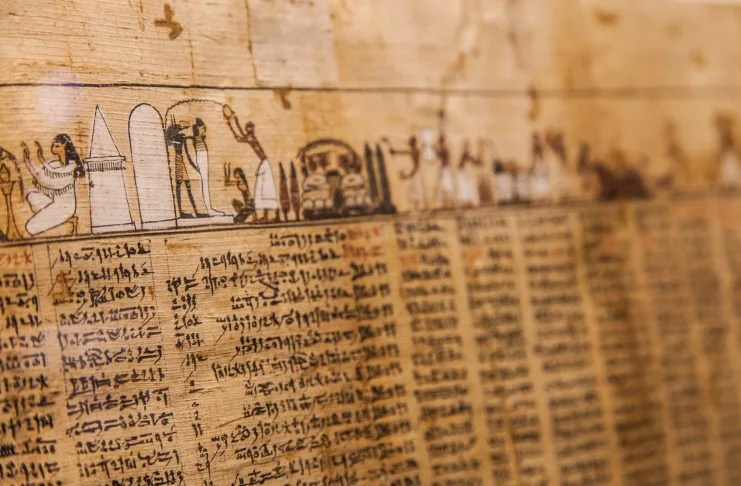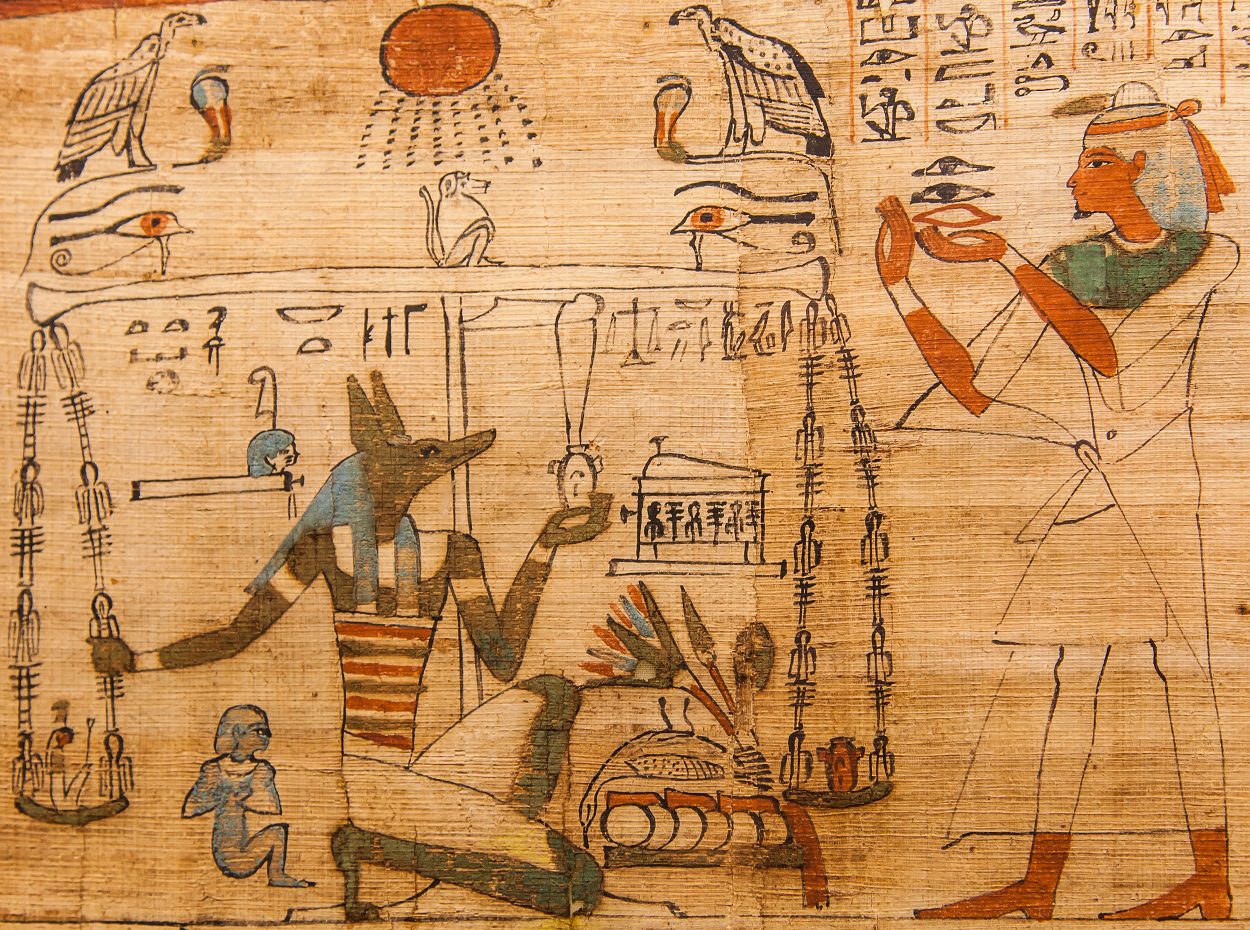
The Ancient Egyptian Book of the Dead: An interview with Prof. Rita Lucarelli
The following is an interview about the Ancient Egyptian Book of the Dead with Prof. Rita Lucarelli by Richard Marranca from Montclair State University.
I am so pleased that you are up for an interview. What are you currently working on?
Currently I am working on a book of demons, including those in the Book of the Dead (BD). In general, I am surprised by how many unknown BD fragments keep being discovered in Egypt and in private and museum collections, which add new knowledge on the ancient Egyptian funerary beliefs.
How did you get interested in Egyptology? And what is your background? And what do you teach at Berkeley?
I always loved archaeology, the Arabic and African world. I have studied Egyptology first at the Oriental Institute in Naples, then received my PhD in Egyptology at Leiden, in the Netherlands. At Berkeley I teach courses on the ancient Egyptian language, religion and recently also about Digital Egyptology, in particular on 3D technology applied to the ancient Egyptian heritage preservation.
What is the Egyptian Book of the Dead? Is that the original name? And what is the time period for its prominence? Does the Book of the Dead draw upon older Egyptian material, or is it something very original?
The Book of the Dead is the name given to a corpus of ancient Egyptian magical, ritual and funerary texts, aiming at protecting the body of the deceased and to accompany him or her during the journey in the regions of the Duat, the ancient Egyptian netherworld. The Egyptians called this collection "peret em heru", "going out by day or in the sunlight", which was a metaphor for rebirth and eternal life after the liminal stage of death.

The corpus is attested for a very long span of time, from the beginning of the New Kingdom (1500 BC) to the Greco-Roman period (332 BC – AD 380). The objects where Book of the Dead spells and vignettes (illustrations) occur are part of the funerary equipment used for the burial rituals: papyri first of all, mummy bandages, linen, coffins, stelas, amulets, canopic boxes (used to keep the soft interiors of the body before mummification) and statuettes; selections of Book of the Dead spells occur also on tomb and temple walls.
Who created these Books and for whom? Was there much freedom in creating them?
The ancient Egyptian theologians and priests composed the spells, which derived from the tradition of magical spells for the dead, which started with the Pyramid Texts. They are therefore traditional texts but there was freedom to re-arrange and to produce new variants of the earlier spells.
There are thousands of extant Books of the Dead. What's papyrus? Why did the Books of the Dead last, sometimes in excellent vivid condition?
Papyrus is a plant that grew in Egypt and was used to make a particular kind of paper that the ancient Egyptian scribes used to write down all sorts of documents. The Book of the Dead papyri were kept in the tomb with the mummified body of the dead and therefore many of them have been preserved in good conditions until the tombs and coffins were open and the papyri brought to the museums around the world.
In contrast to other ancient peoples, the Egyptians seem to have had a good life, plus the afterlife was an ideal reflection of life on earth. Can we assume that life was good, or is that tinged with propaganda? And were the Egyptians obsessed with death?
The ancient Egyptians had a good life according to the social class they belonged to. Even what we call today "slaves" could become free if they were acting well and respected the Pharaoh's laws or if they could show particular skills. They were also obsessed with death in the sense that they believed death was a new beginning and therefore they had to prepare for the journey in the netherworld.
The Egyptians understood that no one returns from the dead. But they strongly believed in the afterlife. So, the ideal was that the person was mummified and the Book of the Dead, in some form or another, was included in the tomb? How were these images, spells and amulets included in the tomb?
Yes, the Book of the Dead had to protect the body and spiritual parts of the dead. The spells and the accompanying images (vignettes) were copied down on papyrus, on the tomb walls, on the coffins as well as on other magical objects that accompanied the dead in the afterlife.
What would the deceased have to say or do to reach the afterlife? Were there many gateways and dangers? Who helped the deceased?
He had to repeat the magical words of the spells, address the divine and demonic inhabitants of the netherworld and know their names and how they look like, in order to go through the many gates of the netherworlds. Some of the deities also helped the deceased.
My understanding is that there are different ways to dwell in the afterlife. The soul (as in Ba and Ka) joined the pharaohs in the firmament? Was it also true that one resided west in the Field of Rushes? And could the person's spirit also reside somehow in tomb or statue?
The mummified body (of the Pharaoh but also of non-royal persons) remained in the tomb, the ba could go in and out of the tomb, the Ka was receiving the offering as a sort of vital force of the deaceased, while the Akh was the transfigured spirit of the dead, after the judgment and living with the gods. The "West" is traditionally seen as the Realm of the Dead (cemeteries were on the west bank of the Nile") so the Field of Rushes may be referred to be in the West (Imenet), while the Westerners (Imentyw) were the dead people.
Who are the main gods & goddesses involved in the journey to the netherworld and the netherworld itself?
Osiris, Anubis, Thot, Horus, Ra but ideally all the gods were part of it.
In "Demonology During the Late Pharaonic and Greco-Roman Periods in Egypt," you wrote that "all supernatural beings in Egypt, whether of the 'demon' or 'god' category, could function both benevolently and malevolently towards people (and each other)?" That's fascinating stuff – can you explain the help and hurt potential here for humans?
If the dead or the living knew how to deal with demonic creatures as well as with the deities, they did not have to fear them – this was the magical knowledge of spells and rituals. Sometimes gods and demons would turn malevolent when they had to inflict a punishment towards humankind, as in the myth of the Destruction of Humankind.
The heart weighed against a feather representing maat opens up a world of questions. Was this like a court case that one had to prove? What happened if one failed? Eaten up?
Yes, it reflects the earthly tribunal with the recitation of the negative confession, when the deceased had to prove his/her innocence. In theory, if it failed, Amemet (the devourer of the dead) will devour the deceased.
Did the person have to have a virtuous life and not been sacrilegious and that kind of thing? What if, like all of us, the person had things to hide? What if your heart spoke out of turn?
Then you will be condemned to pain and punishment in the netherworlds, in a sort of Egyptian Hell represented in the so-called Books of the Netherworld, like the Book of Gates and the Book of the Earth.
Is the Book sort of a reminder for the deceased in case things go wrong? Was the journey the same for rich or poor? I'm thinking — democracy of death? And did the Book serve like the selling of indulgences that the Catholic Church used to do?
The Book of the Dead was a collection of magical spells and only the elite could afford it but also the non-elite believed in the same kind of divine justice, and they were having less rich funerary equipment and shorter papyri, if they could even afford one. I would not compare it to anything in the Catholic Church though, which is based on a different ideology and monotheistic religion.
When and why did the book lose its importance?
Only when the ancient Egyptian civilization disappeared, at the end of the Roman period when the Christians (Copts) arrived in Egypt and destroyed the productions of the indigenous religion.
What are some of the greatest examples of the Egyptian Book of the Dead? What about that famous one that E. A. Wallis Budge bought from a dealer in Egypt?
The Book of the Dead of Ani (bought by Budge) is certainly a masterpiece, we have many other beautifully illustrated papyri like the Book of the Dead of Kha from Deir el Medina (now in Turin) and the very long papyrus Greenfield (in the British Museum 40 meters long)
Did the Book of the Dead influence later religions in the Middle East, as in Judaism, Christianity, and Islam?
It inspired the imagery of the afterlife in other religions, especially the depictions of hell, but not the beliefs of monotheistic religions whose idea of salvation is very different.
Interview by Richard Marranca from Montclair State University
Header Image Credit : Shutterstock
-- Sent from my Linux system.
No comments:
Post a Comment